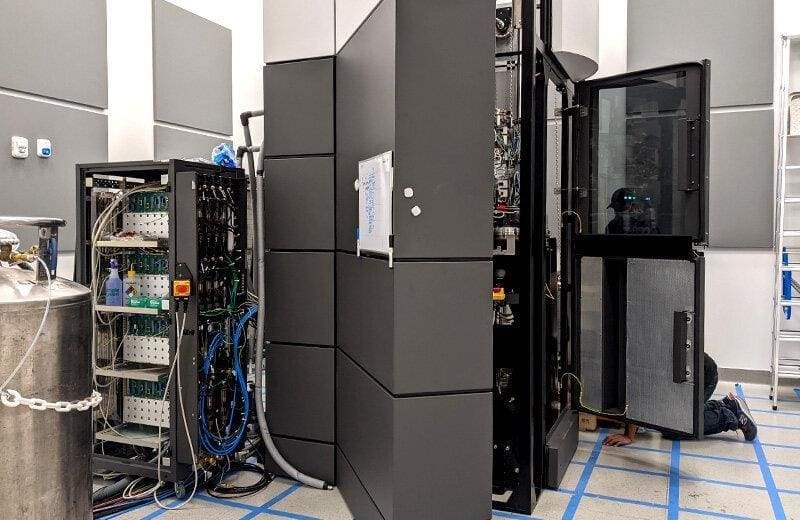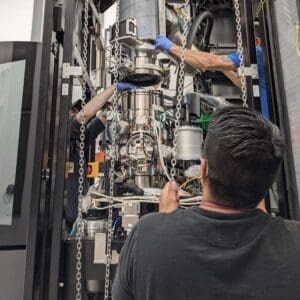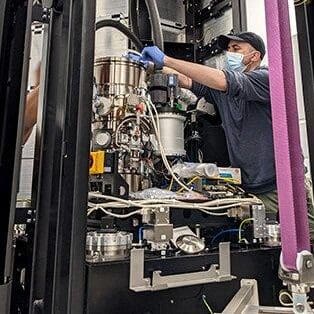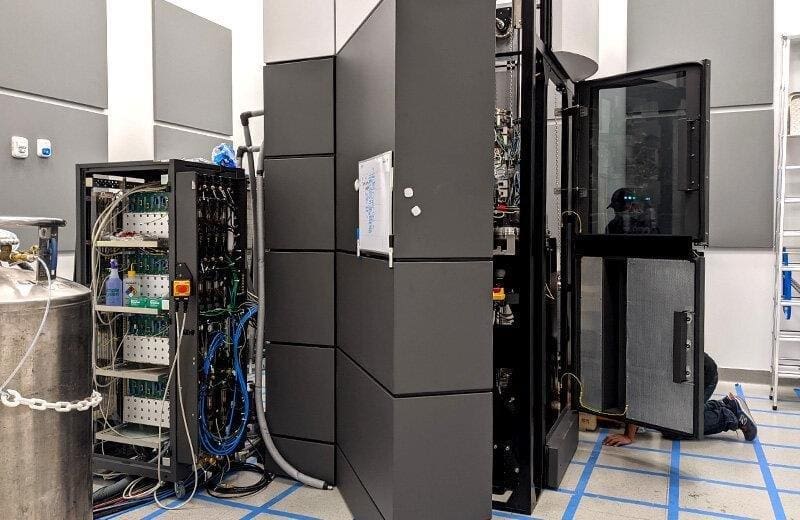New Cutting-Edge Cryo-Electron Microscopy Facility Exemplifies USC Michelson Center’s Vision for Convergent Bioscience.

Credit: Carolyn Marks of USC Core Center of Excellence in Nano Imaging.
By Justin Chapman
A new facility recently opened in the USC Michelson Center on Convergent Bioscience (MCCB) that allows scientists to view and take snapshots of biological molecules in three dimensions through a technique called cryo-electron microscopy (cryo-EM), which is a game-changer for structural biology research.
“These instruments are going to allow people to do things that they weren’t able to do before,” said Cornelius Gati, who heads the cryo-EM facility and joined MCCB in January 2021. “We use cryo-EM to look at things on the atomic scale.”
USC recently signed a co-location agreement with Amgen, meaning both university researchers and the biotech company will share access to two of the world’s most advanced cryo-EM instruments on campus, called Krios and Glacios. Both of the microscopes, which were designed and manufactured by Thermo Fisher Scientific Inc., reside in the Michelson Center.
Researchers will be able to pre-screen samples at moderate resolutions on Glacios, after which they can transfer the best-quality samples for imaging at the highest resolutions on Krios, Thermo Fisher said in a statement.
The instruments are so big that they can’t fit in a regular room. They had to break into the floor above to accommodate the 9-foot-tall structures. Each instrument also has its own control room, so the facility takes up a substantial portion of the basement of the Michelson Center. The center brings together a diverse network of scientists and engineers from the USC Dornsife College of Letters, Arts and Sciences, USC Viterbi School of Engineering, and Keck School of Medicine of USC to collaborate on research on some of the greatest challenges of our time, from cancer to neurological disease to cardiovascular disease.
“Researchers plan to use the [instruments] to complete the development of an atomic-level map of the human cell—one of the university’s most prominent projects.”
—Suzanne Graham, Senior Director of Business Development, Thermo Fisher Scientific Inc.
According to Suzanne Graham, Senior Director of Business Development at Thermo Fisher, the cryo-EM facility will enable researchers from both USC and Amgen to increase their disease research productivity. “Researchers plan to use the [instruments] to complete the development of an atomic-level map of the human cell—one of the university’s most prominent projects,” she wrote.
Charles Zukoski, USC’s Provost and Senior Vice President for Academic Affairs, said the “setup [is] perfectly exemplary of our common vision for convergence,” or the bringing together of various scientific disciplines under one roof to collaborate.
“There is a very broad scope of people who are interested in the cryo-EM facility, from the engineering school all the way to the medical school,” Gati said.The Michelson Center is the largest academic building on USC’s campus at 190,000 square feet and four stories. It was constructed with a $50 million gift from Dr. Gary Michelson and Alya Michelson. The innovative space brings together 20 principal investigators from eight departments as well as hundreds of researchers and students who are employed by the laboratories in the space.

Credit: Carolyn Marks of USC Core Center of Excellence in Nano Imaging
“Microbiologists, cell biologists, material scientists—basically anyone who is interested in the life sciences at the atomic scale,” Gati said. “Some people might be interested in trying to understand how bacteria go about their business, or how insulin was secreted into the body. There are lots and lots of different questions that can be answered with this technique, so there’s a very broad community of people who are interested in using it.”
Gati previously worked with cryo-EM tools at the MRC Laboratory of Molecular Biology in Cambridge, UK, and at Stanford University. He was born in Germany and studied there, Switzerland, and the UK before joining Stanford’s National Lab for four years. His research focuses on neurobiology, synaptic transmission, how neurons communicate, and how these processes are modulated by drugs, both recreational drugs and small molecule inhibitors such as antidepressants.
“What we’re trying to achieve is structural pharmacology,” he said. “We like to understand how drugs, specifically, interact with their receptors on the atomic scale. Obviously, this has direct implications on drug development. We basically provide blueprints for chemists and pharmaceutical companies to develop new drugs against these same receptors or proteins of interest.”
Darrin Joy, Senior Director of Strategic and Scientific Communication at USC Dornsife, wrote that a key step for researchers in developing those new drug targets is “knowing the shape of biological molecules such as proteins and DNA and how their shapes change as they interact with other molecules. One of the most significant advances in structural biology builds on the power of electron microscopy by cooling samples to extremely low temperatures approaching absolute zero, where molecules themselves stop moving altogether.”
The cryo-EM instruments are a game-changer for structural biology research and will result in breakthrough therapies for unmet medical needs.

Credit: Carolyn Marks of USC Core Center of Excellence in Nano Imaging
Amgen is using the cryo-EM instruments to accelerate drug discovery through single particle analysis, microcrystal electron diffraction, and cryo-electron tomography.“We anticipate this equipment will contribute to Amgen’s better understanding of disease mechanisms as we analyze drug targets,” said Philip Tagari, Vice President of Therapeutic Discovery at Amgen. “With the ability to view drug targets in their near-native states at the atomic level, our hope is to bring more speed and power to drug discovery. We are seeing the ‘century of biology’ unfolding. Advances are coming at unprecedented speed, as recently demonstrated by the pace of innovation related to COVID-19. The biopharmaceutical industry, from ‘virtual’ startups to established major pharmaceutical companies, will need to partner with world-class academic institutions in order to best translate new discoveries into breakthrough therapies for unmet medical needs.”
However, a cryo-EM facility is prohibitively expensive to obtain and run, which is why a public-private partnership was critical. The price tag ranges from $1 million to $5 million for each microscope.
“Ownership of a cryo-EM system is beyond the financial means of many academic research institutions,” Joy wrote. “And despite the technology’s value in searching for potential new therapeutic drug targets, even biotechnology or pharmaceutical industry giants may have difficulty justifying some of the expense to their shareholders. But the USC-Amgen co-location agreement solved this problem by combining the company’s capital with the university’s commitment and expertise to run the instruments as well as space in which to locate them.”
The public-private partnership is very unusual in that it’s one of the few industry-academic collaborations of its kind, Gati said. Stephen Bradforth, USC Dornsife’s Divisional Dean for Physical Sciences, added that housing these cryo-EM instruments at the Michelson Center will “drive fundamental research underpinning advances in human health across our campuses. We believe it will help us continue to attract top students and faculty to USC as we dramatically expand our presence in the field of structural biology.”
Learn more about the USC Michelson Center for Convergent Bioscience here and here.

